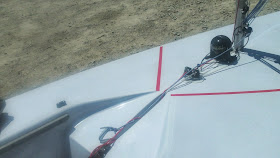By Doug
Pam's favorite class is called a Butterfly, and she has one that has been in her family for more than 40 years. A Butterfly is a small scow designed in the early 60's that is actually pretty neat. Its rounded bottom makes it very responsive and its over-rotating mast makes the mast bend to windward to give the sail a 3-D curve, so the rig is more powerful than a Laser/Torch. There are two things I do not like: 1) its name [and Pam sometimes makes me wear a t-shirt with a big Butterfly on the chest when I race against the Dallas Laser Fleet] and 2) the rudder is a metal plate that stalls out very easily. Scows are sailed mainly on lakes because they do not handle waves well.
Their national championship this year was in Spring Lake, Michigan which was on my way home after the Canadian Laser Masers, plus I had won this before, plus it's always a fun event. So I dropped in, borrowed a brand new boat from Windward Boatworks and was able to defend my title.
I wore my hat cam for some of the races and made three videos that Laser/Torch sailors may enjoy. The first is about starting:
The second is a race that shows the tactics needed to win a race. This was on the second day when the wind increased with gusts of 30 mph according to the local paper:
The third shows a series of bonehead mistakes that I made on the first leg and how I was able to come through the fleet once I got my act together.
Update: at the end of this last video when describing how I caught the leader on the final leg, I ran out of time because of YouTube's 15 minute limit . Here's more detail: I tried to get him to choose between covering me tacking on the shifts/pressure and his preference of staying close to the favored right shore. At one point, I went way close to the shore, he covered, ran aground in the sand, and lost his speed trying to tack away. I think this is where he slowed down enough for me to catch him. Another example of the perils of covering!
This is a really fun class that is a good training boat for Laser/Torch people who live near a lake. And the people it attracts enjoy good competition without the sometimes intimidating intensity of the Laser/Torch class.
This is a really fun class that is a good training boat for Laser/Torch people who live near a lake. And the people it attracts enjoy good competition without the sometimes intimidating intensity of the Laser/Torch class.










